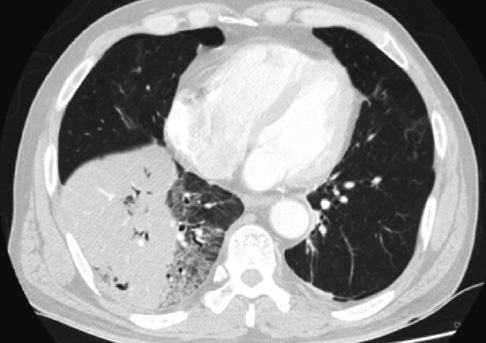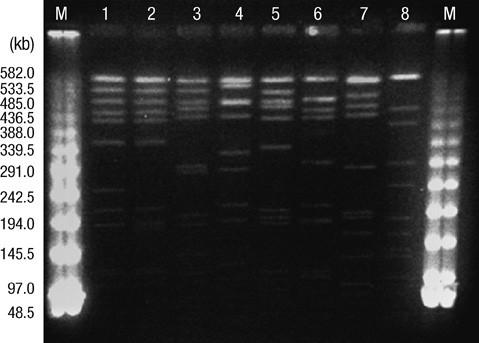J Korean Med Sci.
2012 Mar;27(3):313-316. 10.3346/jkms.2012.27.3.313.
Post-influenza Pneumonia Caused by the USA300 Community-Associated Methicillin-Resistant Staphylococcus aureus in Korea
- Affiliations
-
- 1Division of Infectious Diseases, Department of Internal Medicine, Samsung Medical Center, Sungkyunkwan University School of Medicine, Seoul, Korea. drchung@skku.edu
- 2Asia Pacific Foundation for Infectious Diseases (APFID), Seoul, Korea.
- 3Department of Molecular Cell Biology, Sungkyunkwan University School of Medicine, Suwon, Korea.
- KMID: 1793004
- DOI: http://doi.org/10.3346/jkms.2012.27.3.313
Abstract
- Panton-Valentine leukocidin (PVL)-positive USA300 clone has been the most successful community-associated methicillin-resistant Staphylococcus aureus (CA-MRSA) clone spreading in North America. In contrast, PVL-negative ST72-CA-MRSA has been predominant in Korea, and there has been no report of infections by the USA300 strain except only one case report of perianal infection. Here, we describe the first case of pneumonia caused by the USA300 strain following pandemic influenza A (H1N1) in Korea. A 50-year-old man was admitted with fever and cough and chest radiograph showed pneumonic consolidation at the right lower lung zone. He received a ventilator support because of respiratory failure. PCR for pandemic influenza A (H1N1) in nasopharyngeal swab was positive, and culture of sputum and endotracheal aspirate grew MRSA. Typing of the isolate revealed that it was PVL-positive, ST 8-MRSA-SCCmec type IV. The analysis of the PFGE patterns showed that this isolate was the same pulsotype as the USA300 strain.
MeSH Terms
-
Community-Acquired Infections/*etiology/microbiology
Humans
Influenza A Virus, H1N1 Subtype
Influenza, Human/*complications
Male
*Methicillin-Resistant Staphylococcus aureus/classification/isolation & purification
Middle Aged
Pneumonia, Staphylococcal/*etiology/microbiology
Republic of Korea
Staphylococcal Infections/*etiology/microbiology
Figure
Cited by 1 articles
-
A Case of a Submandibular Abscess caused by Panton-Valentine leukocidin Positive USA 300 Community-associated Methicillin Resistant Staphylococcus aureus in a Foreign Resident of South Korea
Donghyong Jeong, Sangsoo Bae, Inyub Baek, Sangdong Kim, Boyean Kim, Ki Tae Kwon, Kwan Soo Ko, Shinwon Lee
Infect Chemother. 2012;44(6):495-498. doi: 10.3947/ic.2012.44.6.495.
Reference
-
1. Deleo FR, Otto M, Kreiswirth BN, Chambers HF. Community-associated meticillin-resistant Staphylococcus aureus. Lancet. 2010. 375:1557–1568.2. Moran GJ, Krishnadasan A, Gorwitz RJ, Fosheim GE, McDougal LK, Carey RB, Talan DA. EMERGENcy ID Net Study Group. Methicillin-resistant S. aureus infections among patients in the emergency department. N Engl J Med. 2006. 355:666–674.3. Kim ES, Song JS, Lee HJ, Choe PG, Park KH, Cho JH, Park WB, Kim SH, Bang JH, Kim DM, Park KU, Shin S, Lee MS, Choi HJ, Kim NJ, Kim EC, Oh MD, Kim HB, Choe KW. A survey of community-associated methicillin-resistant Staphylococcus aureus in Korea. J Antimicrob Chemother. 2007. 60:1108–1114.4. Song JH, Hsueh PR, Chung DR, Ko KS, Kang CI, Peck KR, Yeom JS, Kim SW, Chang HH, Kim YS, Jung SI, Son JS, So TM, Lalitha MK, Yang Y, Huang SG, Wang H, Lu Q, Carlos CC, Perera JA, Chiu CH, Liu JW, Chongthaleong A, Thamlikitkul V, Van PH. ANSORP Study Group. Spread of methicillin-resistant Staphylococcus aureus between the community and the hospitals in Asian countries: an ANSORP study. J Antimicrob Chemother. 2011. 66:1061–1069.5. Bae IG, Kim JS, Kim S, Heo ST, Chang C, Lee EY. Genetic correlation of community-associated methicillin-resistant Staphylococcus aureus strains from carriers and from patients with clinical infection in one region of Korea. J Korean Med Sci. 2010. 25:197–202.6. Park CM, Lee DG, Choi SM, Park SH, Choi JH, Yoo JH, Hur JA, Shin WS. A case of perianal abscess due to Panton-Valentine leukocidin positive community-associated methicillin-resistant Staphylococcus aureus: report in Korea and literature review from the Far East. Infect Chemother. 2008. 40:121–126.7. Enright MC, Day NP, Davies CE, Peacock SJ, Spratt BG. Multilocus sequence typing for characterization of methicillin-resistant and methicillin-susceptible clones of Staphylococcus aureus. J Clin Microbiol. 2000. 38:1008–1015.8. Koreen L, Ramaswamy SV, Graviss EA, Naidich S, Musser JM, Kreiswirth BN. spa typing method for discriminating among Staphylococcus aureus isolates: implications for use of a single marker to detect genetic micro- and macrovariation. J Clin Microbiol. 2004. 42:792–799.9. Lina G, Piémont Y, Godail-Gamot F, Bes M, Peter MO, Gauduchon V, Vandenesch F, Etienne J. Involvement of Panton-Valentine leukocidin-producing Staphylococcus aureus in primary skin infections and pneumonia. Clin Infect Dis. 1999. 29:1128–1132.10. Yinduo J. Methods in molecular biology: MRSA protocols. 2007. Totowa, NJ: Humana Press, Inc..11. Blanco R, Tristan A, Ezpeleta G, Larsen AR, Bes M, Etienne J, Cisterna R, Laurent F. Molecular epidemiology of Panton-Valentine leukocidin-positive Staphylococcus aureus in Spain: emergence of the USA300 clone in an autochthonous population. J Clin Microbiol. 2011. 49:433–436.12. Nagao M, Linuma Y, Suzuki M, Matsushima A, Takakura S, Ito Y, Ichiyama S. First outbreak of methicillin-resistant Staphylococcus aureus USA300 harboring the Panton-Valentine leukocidin genes among Japanese health care workers and hospitalized patients. Am J Infect Control. 2010. 38:e37–e39.13. Kwon JC, Kim SH, Park SH, Choi SM, Lee DG, Choi JH, Park C, Shin NY, Yoo JH. Molecular epidemiologic analysis of methicillin-resistant Staphylococcus aureus isolates from bacteremia and nasal colonization at 10 intensive care units: multicenter prospective study in Koera. J Korean Med Sci. 2011. 26:604–611.14. Centers for Disease Control and Prevention (CDC). Bacterial co-infection in lung tissue specimens from fatal cases of 2009 pandemic influenza A (H1N1): United States, May-August 2009. MMWR Morb Mortal Wkly Rep. 2009. 58:1071–1074.15. Chickering HT, Park JH. Staphylococcus aureus pneumonia. JAMA. 1919. 72:617–626.16. Pallin DJ, Egan DJ, Pelletier AJ, Espinola JA, Hooper DC, Camargo CA Jr. Increased US emergency department visits for skin and soft tissue infections, and changes in antibiotic choices, during the emergence of community-associated methicillin-resistant Staphylococcus aureus. Ann Emerg Med. 2008. 51:291–298.17. Murray RJ, Robinson JO, White JN, Hughes F, Coombs GW, Pearson JC, Tan HL, Chidlow G, Williams S, Christiansen KJ, Smith DW. Community-acquired pneumonia due to pandemic A(H1N1)2009 influenzavirus and methicillin resistant Staphylococcus aureus co-infection. PLoS One. 2010. 5:e8705.18. Lee MH, Arrecubieta C, Martin FJ, Prince A, Borczuk AC, Lowy FD. A postinfluenza model of Staphylococcus aureus pneumonia. J Infect Dis. 2010. 201:508–515.19. Hageman JC, Uyeki TM, Francis JS, Jernigan DB, Wheeler JG, Bridges CB, Barenkamp SJ, Sievert DM, Srinivasan A, Doherty MC, McDougal LK, Killgore GE, Lopatin UA, Coffman R, MacDonald JK, McAllister SK, Fosheim GE, Patel JB, McDonald LC. Severe community-acquired pneumonia due to Staphylococcus aureus, 2003-04 influenza season. Emerg Infect Dis. 2006. 12:894–899.20. Boussaud V, Parrot A, Mayaud C, Wislez M, Antoine M, Picard C, Delisle F, Etienne J, Cadranel J. Life-threatening hemoptysis in adults with community-acquired pneumonia due to Panton-Valentine leukocidin-secreting Staphylococcus aureus. Intensive Care Med. 2003. 29:1840–1843.
- Full Text Links
- Actions
-
Cited
- CITED
-
- Close
- Share
- Similar articles
-
- A Fatal Case of Infective Endocarditis Caused by Community-Associated Methicillin-Resistant Staphylococcus aureus ST72 in Korea
- A case of multiple furunculosis caused by methicillin-resistant staphylococcs aureus
- Community-associated methicillin-resistant Staphylococcus aureus (CA-MRSA)
- Detection of Multidrug Resistant Patterns and Associated - genes of Methicillin Resistant Staphylococcus aureus ( MRSA ) Isolated from Clinical Specimens
- A statistical analysis of methicillin-resistant staphylococcus aureus



